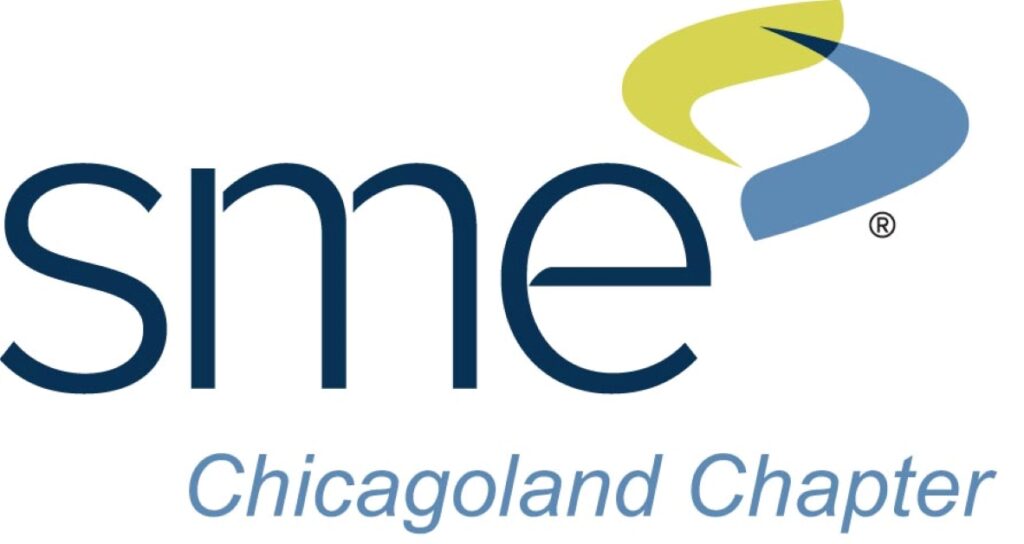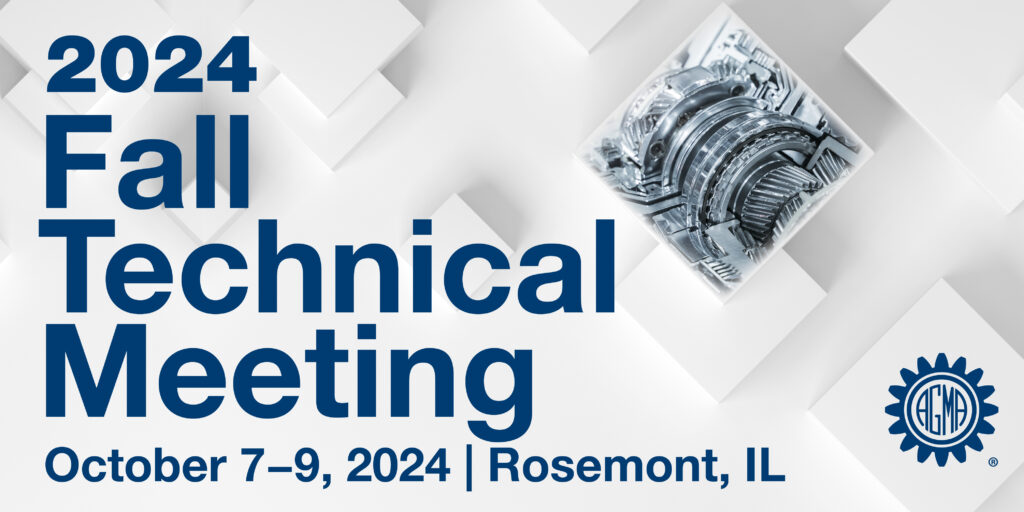
The 2024 Fall Technical Meeting (FTM) will be on October 7-9, 2024, at the Hyatt Rosemont in Rosemont, IL.
Technology is fundamentally changing the way manufacturing is done. The gear industry is faced with emerging trends and innovation that is challenging engineers to stay in course with cutting-edge technology to keep design, quality, materials and analysis efficient. It is imperative that researchers and gear engineers communicate ideas with fellow experts in the field. AGMA’s annual Fall Technical Meeting (FTM) is the perfect forum in which to share research and to disperse knowledge for the benefit of the industry at a global level.
Each year, authors selected by AGMA write technical papers on topics relevant to the gear industry. These may include subject matter related to: design and analysis; manufacturing and quality; materials, metallurgy, and heat treatment; operation, maintenance, and efficiency; and gear failure. The papers then go through a double-blind peer review process in order to ensure the efficacy of the research. The authors then present the results of their work at the FTM to an audience of knowledgeable international engineering professionals. During a Q&A period at the end of each session, authors and attendees are able to exchange their ideas.
Note:
- Scheduled times are subject to change.
- Full Registration includes PDFs of all 2024 FTM papers.
- Single-session registrants can purchase tickets separately for other events.
All Fall Technical Meeting questions should be sent to FTM@agma.org.
Before registering for the Fall Technical Meeting and SME Chicagoland Heat Treat Training, you will be asked to create an AGMA account in order to sign up if you do not already have an AGMA profile. After clicking the Register button above, click “Create a new account” to set up your profile or log in using your existing account. If you have any questions about your account, please contact schuh@agma.org.
Early Bird lasts until August 16.
Advance is available after Early Bird until September 30.
Academic discounts available upon request.
Full Registration
Member Early Bird/Advance/On-site
$1,250/$1,350/$1,450
Nonmember Early Bird/Advance/On-site
$1,650/$1,750/$1,850
Single-Session Registration
Member Early Bird/Advance/On-site
$400/$425/$450
Nonmember Early Bird/Advance/On-site
$500/$525/$550
SME Special Session
Registration for the pre-conference training can be added to your FTM registration fee or you can register for the training alone.
Flat Rate
$200/per person
Hotel Information
Hyatt Rosemont
6350 N River Rd
Rosemont, IL 60018
Room Rate
The discounted rate for FTM attendees is $159 per night. The deadline to reserve your room at the discounted rate is September 9, 2024.
Schedule
- Monday, October 7
- Tuesday, October 8
- Wednesday, October 9
10:00am – 5:00pm
Registration Open
Lindbergh Foyer
10:00am – 12:00pm
SME Chicagoland Heat Treat Training
Coleman A
Registration for the pre-conference training is $200 per person and can be added to your FTM registration fee or you can register for the training alone.
- The Heat Treat training is presented by SME (Chicago Chapter) and held in conjunction with the AGMA Fall Technical Meeting.
- Topics presented will focus on successful methods for heat treating of gears and managing distortion.
The training will consist of three presenters who are recognized experts in the area of heat treating. The presenters and their specific subject areas are as follows:

Dan Herring
Herring has spent his career in the heat treatment industry addressing heat treating, brazing and sintering problems. The author of over seven hundred (700) published papers and seven (7) books including Vacuum Heat Treatment (Volume 1 & 2) published in 2012/2015, Atmosphere Heat Treatment published in 2014/2016 as well as several e‐books entitled A Comprehensive Guide to Heat Treatment (Volume 1 & 2) released in 2018 and Metallurgical Fundamentals of Heat Treating released in 2021. “The Heat Treat Doctor” is dedicated to advancing the state‐ of‐the‐art in the thermal processing field.
Herring’s Presentation
- Gear materials and their heat treatment
- Critical considerations – microstructure & properties
- Preventing gear failures by intelligent heat treatment
- Ways in which to optimize gear heat treatment in atmosphere furnaces
- Ways in which to optimize gear heat treatment in vacuum furnaces

Arvid Casler
Casler has a long history of applied expertise in the heat-treating sector for manufacturing. Previously, Casler was the Chief Metallurgist for Northstar Aerospace, and is now General Manager of Element Chicago which is a material testing laboratory. Casler is a Frost & Sullivan and Presidential Service Award recipient (2016), and his affiliations include the ASTM E28 Committee, the Rockford‐Stateline Chapter of ASNT, and several committees of ASM International while a current member of NACE, AIME/TMS, STLE and SAE.
Casler’s Presentation
- Review of starting material conditions, including basic product forms, forged, wrought, cold rolled, and hot rolled
- Basic furnace designs and fixturing vs. furnace load
- Sources of distortion ‐ brief review of the development of residual stress, stress relief, how to identify which is which (shape vs. size), and intermittent stress relief (inclusion of masking materials)
- Quenching primer ‐ media vs. distortion, prediction methods, and quench phases
- Quench press use
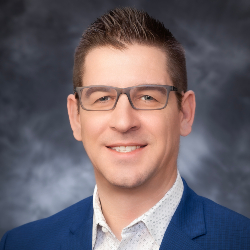
Tom Hart
Hart is a seasoned Product Manager specializing in Vacuum Furnaces at SECO/VACUUM. Tom draws from the experience of his 20‐year career in precision manufacturing and heat treatment industries. In his role, Tom collaborates closely with partners, providing invaluable insights into heat treatment processes, equipment, and infrastructure specific to vacuum furnaces. His knowledge spans various heat treatment techniques, including hardening, annealing, low‐ pressure carburizing, tempering, sintering, vacuum brazing, and more.
Hart’s Presentation
- An overview focusing on gear heat treatment with low pressure carburizing and the three methods of quenching (batch oil, batch gas and 4DQ)
- A detailed look at the newer 4DQ process – which in most cases can eliminate the need for die press quenching

1:00pm – 5:00pm
Session 1: Materials & Heat Treatment
Lindbergh Ballroom
The Role of In-Situ Techniques in Microstructure Optimization of Interstitially Alloyed Steels
Qianchen Zeng, Worcester Polytechnic Institute
Microstructure optimization of steel for improved performance requires detailed knowledge of the thermal response of the materials. When designing heat treatments of new materials, in-situ information about, for example, phase transformation, is pivotal. In this work, in-situ techniques are applied for mapping the heat treatment response of three technologically relevant materials systems. It is showcased how in-situ techniques can be applied to record the heat treatment response of these generically different special materials. It is also emphasized how nitrogen can be actively used in steels, which can pave the way for more widespread use of nitrogen containing steels. The topic of using high carbon steels in additive manufacturing is also addressed.
Durability and Performance Rating Procedures for Plastic Spur Gears
Dr. Damijan Zorko, RD Motion, d.o.o.
High performance plastic gears are increasingly replacing metal gears in several applications due to their many advantages. Lower weight, no need for lubrication, cheaper mass production, significantly better NVH and chemical/corrosion resistance are just a few of these advantages. To ensure a reliable gearbox operation, gears need to be appropriately designed in order to avoid failure within the required lifespan. There is currently no international standard available for the mechanical design of plastic gears. The most up-to-date is VDI 2736, which provides the design rating procedures for all common failure modes. A significant lack of required material data is the major drawback preventing a larger adoption of plastic gears. The present study provides experimental methodologies, which can be employed to characterize the gear-specific material data.
A Preliminary Study on a Novel Procedure for the Assessment of Fatigue Performance of PA6 Polymer Gears
Dr. Riccardo Longato, Longato Riccardo Srls
In the present study, experimental tests are conducted in accordance with the standard for both procedures and equipment, but a new procedure is conceptualized for the evaluation of plastic gears. For the test setup, the gears are installed in a climate chamber to achieve the correct temperature test control. With an infrared camera and temperature feedback software, the temperature is set at 30°C. From the triplet σFlimNi (fatigue strength) Ni (number of cycles) θi (temperature) data for each performed test, it is possible to determine a point on the temperature-dependent Wöhler curve. From this curve, the novel approach consists in the forecast of time to failure assuming a Weibull fault distribution. The obtained results are compared with the standard VDI 2736 approach.
Bending Fatigue Strength of Gear Steels for Automotive Electric Drive Units
Christopher Aylott, Newcastle University
Gear bending fatigue tests were conducted on three commercially available carburizing steels to support the development of gearing for future automotive electric drive units, which requires increased power density, efficiency and reliability. 20MnCr5 was selected as the baseline steel, Ovako 236Q was selected to investigate the effect of inclusion content and Ovako 158Q (20NiMo9-7F) was selected to investigate the effect of reduced intergranular oxidation. Both candidate steels outperformed the baseline steel in the as-carburized condition with further improvements in finite life performance and/or mean strength achieved through the use of duplex shot peening or root grinding. The work outlined in this paper has therefore shown the ability for alternative steel selection to either achieve increased power density or decrease cost through reduction of manufacturing stages.
Analysis of Tooth Bending Fatigue of AISI 9310 Gears Through Strain-Based Criteria
Dr. Lorenzo Pagliari, Free University of Bozen/Bolzano
This paper aims at assessing the applicability of strain-based criteria for the fatigue characterization of gears. Specifically, four different strain-based criteria based on the theory of critical plane were investigated. Experimental data on AISI 9310 spur gears using the single tooth bending method to achieve crack initiation was considered. Stress and strain tensors developed during the tests were calculated through a finite element model and were numerically elaborated through the selected criteria, obtaining different predictions. This study managed to demonstrate that strain-based criteria can also be employed for the fatigue analysis of gears, and that they have the capabilities of characterizing certain features of gear fatigue behavior with very high accuracy, representing a practical tool for companies to quickly estimate the fatigue behavior of gears.
Experimental Study on the Performance of Plastic Worm Gears
Dr. Borut Černe, RD Motion, d.o.o.
Worm gears are a common type of plastic gears, employed in several actuators, ranging through different industries: automotive, appliances, medical. Despite the fact that plastic worm gears are very commonly used, there has been comparatively limited research done on their performance characteristics. Data on how different plastic materials perform in a worm gear transmission is almost non-existing. The majority of applications are designed based on an empirical know-how and by employing conservative methods leading to an overdesign. The study provides a comprehensive overview of the state-of-the art models available for conducting design rating procedures of plastic worm gears. Corresponding to the design models, experimental methods are proposed, which can be used to characterize materials performance under specific load conditions which arise in worm gear pairs.
5:30pm – 6:30pm
Welcome Reception
Coleman Ballroom
7:00am – 5:00pm
Registration Open
Lindbergh Foyer
7:00am – 8:00am
Breakfast
Coleman Ballroom
8:00am – 12:00pm
Session 2: Applications
Lindbergh Ballroom
Design Alternative for a Helicopter Final Stage Planetary Gearbox, Introducing the Innovative Orbicular Gear Mechanism (OGM)
Mert Vardar, Tr Transmisyon Engineering
The Orbicular Gear Mechanism (OGM) is a promising alternative to traditional planetary gear systems, particularly in aerospace applications. Unlike conventional designs, OGM utilizes face gears for the sun and ring gears, resulting in superior compactness and weight reduction. Its unique configuration maximizes planet gears relative to reduction ratios, enabling smaller yet similarly efficient gearboxes. OGM also minimizes centrifugal effects on the planets, allowing for high-speed operation. Overall, OGM presents a promising solution for aerospace applications, offering enhanced load distribution, weight reduction, and compactness compared to traditional planetary gear configurations.
Analytical Calculation of the Gear Body Stiffness of Face Gears
Jonas-Frederick Berger (b. Hochrein), Institute of Machine Elements, Gear Research Center (FZG), TUM School of Engineering and Design, Technical University of Munich
Due to the constantly increasing requirements, more and more transmissions are being adapted and developed for their specific application. It is of paramount importance to optimally exploit the potential of the gears. Target criteria can be the NVH behavior and/or the maximum carrying capacity. To evaluate these objectives, it is crucial to know the load distribution in the meshing. The load distribution is usually determined with loaded tooth contact simulation (LTCA), based on the stiffnesses of the machine elements in the gearbox. This paper presents and discusses a novel approach to determine the wheel body stiffness for disk-like gears. The face gear drive serves as a demonstrator, whereby the approach can be transferred to other angular gears (e.g. bevel gears) without any difficulty.
Electric vs. Combustion: A Comparative Analysis of Gear Design for Commercial Vehicle Applications
Carlos Wink, Eaton Corporation
The automotive industry has seen a significant shift from Internal Combustion Engines (ICE) to Electric Vehicles (EV) over the past decade, primarily in passenger cars. Compared to that, the commercial vehicle sector is now beginning to explore EVs. The gear design approach for EV is different from conventional ICE. These gears run at higher speeds and are prone to issues like severe pitting, micropitting, scuffing, power loss, and gear whine. This paper explores the design of gears for commercial EV applications, compares it with conventional ICE gear design, and identifies critical parameters for risk mitigation and improved NVH.
Gearbox NVH Analysis – An Engineering Approach
Timo Giese, FunctionBay GmbH
Enhancing acoustic comfort in gearbox engineering is crucial, necessitating advanced computational models and simulations for predicting and improving noise, vibration, and harshness (NVH) performances. Comprehensive evaluations require extensive experimental data to validate structural, dynamic, and acoustic characteristics. This paper presents an engineering approach for investigating gearbox NVH performances. Numerical and Experimental Modal Analysis (NMA/EMA) validate the natural frequencies of structural components, with data compared using the Modal Assurance Criterion (MAC). Simplified modeling guidelines for housing bolted connections are derived. A flexible multibody gearbox model is developed using modal reduction techniques and advanced gear and bearing contact formulations, validated through dynamic simulations. Finally, a time domain boundary element method (TD-BEM) is used for numerical acoustic analysis under dynamic conditions.
Design Method of System Tolerances in Cylindrical Gearboxes for Cost-Efficient Optimization of the Excitation Behavior
Laurenz Roth, M.Sc, Laboratory for Machine Tools and Production Engineering (WZL) of RWTH Aachen University
The design of cylindrical gears is often carried out separately from the development of surrounding gearbox components. This applies in particular to the procedure for defining the tolerances. Mostly, experience is used when the tolerance limits of surrounding housing components, shaft shoulders, rolling bearing operating clearances or bores are defined. The definition of restrictive tolerance limits determines the appropriate manufacturing processes, that are suitable for achieving the tolerance requirements. That influences the total manufacturing costs. The aim of the paper is to develop a method that enables a tolerance design for various types of deviations within a gearbox with cylindrical gears. It takes into account the tolerance’s relevance for the noise excitation of the gears and the manufacturing costs resulting from the individual manufacturing requirement.
Calculation of the Scuffing Load Capacity of Spur Gears Using a Local Thermophysical Approach
Mathis Steinrötter, Ruhr University Bochum
Efforts to achieve global climate targets require efficient drive systems with high power density, increased speed, and low-viscosity lubricants. However, these factors reduce scuffing load capacity, a key limitation in high-speed gearbox design. Scuffing is influenced by tribological stress, friction conditions, lubricant formulation, and materials. The flash temperature method (ISO 6336-20) verifies scuffing load capacity but is limited to speeds below 50 m/s, which current trends exceed. The standard method empirically models material influence, restricting technological progress. This article introduces a new calculation method for high-speed cylindrical gears, considering material thermophysical properties. Unlike ISO 6336-20, it uses a lubricant-specific characteristic curve, with permissible flash temperature based on the PECLET number, referencing conductive and convective heat properties. This method enhances power density in drive systems.
12:05pm – 1:05pm
Awards Luncheon
Coleman Ballroom
1:10pm – 5:00pm
Session 3: Design & Rating
Lindbergh Ballroom
Influence of Reverse Loading on the Tooth Flank Fracture Load Capacity
Johannes Rolzhäuser, Laboratory for Machine Tools (WZL) of RWTH Aachen University
Due to near surface optimization in the last years, tooth flank fractures are increasingly occurring. The influence of reverse loading (e.g. in planet gears) on the tooth flank fracture load capacity is currently only known to a limited extent. Hence, the aim of this report is the investigation of the influence of the reverse loading on the tooth flank fracture load capacity. For this purpose, a FE-based tooth flank fracture load capacity calculation is extended. Subsequently, a simulation study is carried out, in which the load capacity as well as the location of the crack initiation is investigated for reverse loading. Finally, first experimental tests are carried out on a reverse bending test rig.
Categorization of Gear Stiffness Methodologies, Workflows and Software
Adam Foltz, Purdue University in Indianapolis
A comprehensive breakdown of the different methodologies, workflows and software used for the determination of gear stiffness in loaded tooth contact analysis (LTCA) is covered. A brief history of the most important papers in the field is presented. A breakdown of the different analytical formulations for the various components of gear stiffness is given, along with the papers they originated from. A total of ten different LTCA schemes seen in both commercial and academic software are covered, along with eight different workflows that can be used in the LTCA process. Fifteen different subtleties in the LTCA algorithms, and seven separate areas for research in the field were discussed. The references include all relevant work discussed sorted in chronological order.
Evaluation of Gear Contact Fatigue Surface Integrity Aspects in Fatigue Lifetime Using the Barkhausen Noise Technique
Bruno Henrique Lima, M.Sc, Instituto Tecnológico de Aeronáutica
This study addresses the Magnetic Barkhausen Noise (MBN) technique to monitor contact fatigue early stages evolution in gears. Fatigue testing was conducted inducing a natural evolution of gear contact fatigue. Monitoring MBN signals at regular intervals during testing allowed for correlation with surface integrity degradation. Furthermore, the study delves into microstructural aspects related to contact fatigue. In-depth analyses of residual stresses, microstructure, and microhardness provided a comprehensive understanding of surface degradation. Early contact fatigue stages were characterized by surface softening in the near-surface region, up to approximately 40 µm depth, accompanied by a less compressive residual. Results revealed a significant variation in MBN signals influenced by operational loads during tests, with a noteworthy increase observed just before gear failure.
Investigation of Gear Involute Deviations Under Press-Fit Conditions
Dr. Anusha Anisetti, Eaton Corporation
Tooth form is critical to gear performance. Intentional design modifications and manufacturing deviations of tooth flanks affect load distribution of the meshing teeth and consequently bending stress, contact stress, and gear noise. Gears are connected to the rotating shafts through different ways, such as splines, keyways, welding, and interference fit. Press/Shrink fit is largely used to assemble automobile gears; however, it causes deformation in gear teeth during the assembly process. In this paper, the main focus is to examine this assembly deviation of the tooth profile and its impact on gear contact fatigue life. A simple correction on gear teeth involute during design process is proposed to help improve the conjugate gear meshing conditions and consequently life while facilitating manufacturing of the design intended gears.
Influence of Unbalanced Sliding Conditions on the Pitting Load Carrying Capacity of Internal Gears
Michael Geitner, Gear Research Center (FZG), Technical University of Munich
Macropitting occurs predominantly in contact areas of negative specific sliding. Positioning pitch point C outside of the active profile for internal gears allows to completely avoid negative sliding either on planet or ring gear. The pitting resistance of each partner can be affected by positioning of C and the resulting differences in specific sliding, allowing a lifetime optimization of the full gear stage. Systematic investigations on the pitting load capacity with representative internal gear geometries in different material pairings were performed. The results confirm a distinct influence of unbalanced sliding conditions, showing a significant increase of the pitting load capacity by avoiding areas of negative sliding on the ring gear, while an exposure to negative sliding only leads to a reduction of the pitting resistance.
Influence of Nonlinear Cumulative Damage in Gear Lifetime Analysis
Riley Damm, The Ohio State University
In many gearing applications, the gearbox or transmission system is subject to complex load spectra and mission cycle loading. Many classical and contemporary studies have shown that damage accumulation in metals is nonlinear, and the order of the loading should not be ignored. Yet, standard calculation methods for gears such as ISO 6336-6:2019, ANSI/AGMA 2001-D04, and IEC 61400-4:2012 still employ a linear damage rule. In this study, various damage rules are leveraged to perform lifetime analyses of gears subject to variable loading. ISO 6336-6:2019 is utilized as an example realistic mission cycle for a gear. The influence of load spectra order, mission cycle length and load spectral content on estimated design life using nonlinear damage is explored.
SPECIAL PRESENTATION: Design Automation for High Speed Gears
Dr. Burkhard Pinnekamp, RENK (retired)
High speed gears for industrial applications such as power generation or compressor drives are built according to general design rules but usually have specific performance parameters such as speed, ratio, and power. Moreover, the location of driving and driven equipment may vary. This is a typical engineer-to-order process, which is suitable to be assisted by design automation. This paper presents an advanced program system used to define design and performance parameters, create customer documents and develop data for the complete production cycle. All data are created in a short time, and before a quotation is made to the customer. This presentation describes different process types for different products and, as one example for improved digital processes, the development process for high-power, high-speed gears with design automation.
6:00pm – 8:00pm
Networking Reception
Dave & Busters in Rosemont, IL
7:00am – 1:00pm
Registration Open
Lindbergh Foyer
7:00am – 8:00am
Breakfast
Coleman Ballroom
8:00am – 12:00pm
Session 4: Efficiency, Lubrication, & NVH
Lindbergh Ballroom
Advanced Gearbox Lubrication Analysis: A Virtual Lab for Design Optimization
Benjamin Beckelynck, B.ING, M.Sc, Optimec Consultants Inc.
This paper presents a workflow for gearbox lubrication analysis using advanced CFD and heat transfer simulations. Developed with a client transitioning to electric vehicles, the workflow addresses complex lubrication physics and bearing overheating issues. By creating a digital twin, we enabled a virtual lab environment for testing multiple scenarios, significantly reducing time and cost. Leveraging GPU power, the XFlow 2023 solver cuts computation times from weeks to days. This approach allows rapid iteration and optimization of gearbox designs, improving efficiency and lifespan while preventing flaws. Validated through visual comparisons, churning loss measurements, and temperature data, the workflow enhances product performance, accelerates development timelines, and reduces costs, providing a robust tool for engineering challenges.
Nanocomposite Coatings for Gears
Dr. Peter Schmidt, PE, United Protective Technologies, LLC, UNCC PORTAL
Plasma-deposited nanocomposite coatings can offer substantial operational performance and durability improvements to interfaces in rolling or sliding contact without significantly adding to overall part volume or affecting heat treatment of the substrate. This work describes the development and initial testing of a thin film coating system designed for aerospace gear sets. The predecessor coating system was developed for use on racing hypoid gear sets and has been successfully deployed on automotive platforms. Dynamometer testing of vehicles employing this coating showed a nontrivial increase in brake horsepower available. Test results are reported. Gear surface finish data and photographs are also included, with examples shown prior to testing and after testing.
CFD Simulation of Power Losses and Lubricant Flow in Gearboxes
Dr. Franco Concli, Prof.-Ing., Free University of Bozen/Bolzano
Efficiency has become an increasingly crucial factor. Being able to predict efficiency and lubrication in gearboxes remains an imperative engineering challenge. Existing mathematical models available in literature rely on empirical relations, providing accurate results only within narrow operating ranges.
The implementation of a computationally efficient mesh-handling strategy, along with the development of advanced solvers capable of addressing new phenomena like cavitation, aeration, oil suspension or unconventional lubrication (e.g., non-Newtonian fluids), has made CFD ready for an extensive industrial application for the simulation of lubricated systems. Compared to a decade ago, the computational effort has been slashed by 97%, enabling the simulation of complex systems.
This paper presents application examples across various gear types, showcasing the versatility of the developed approach showing some real case studies.
How to Replace Oil as a Lubricant in Worm Gearboxes with Grease
Felix Müller, M.Sc, Chair of Machine Elements, Gears, and Tribology (MEGT), Rheinland-Pfälzische Technische Universität (RPTU)
This work explores the use of lubricating grease as an alternative to oil in worm gearboxes, driven by specific requirements and environmental conditions. Switching to grease necessitates new approaches to gearbox design, calculation, and tribological analysis. The study examines the rheological properties of greases, their tribological behavior, and lubricant distribution in gearboxes. Various lubricants are tested using tribometers, and their behavior in real worm gearboxes is analyzed. Experimental results, including film thickness, viscosity, and friction coefficient measurements, are compared with analytical methods. Tests also analyze grease distribution using fluorescent particles during operation. The findings highlight the potential of greases in worm gears, enabling the prediction of friction and informing gearbox design adjustments.
Mitigation of Gear Whine Noise in Agricultural Tractor Application
Prashant Bardia, John Deere India
This study focuses on reducing gear whine noise in tractors through simulation and physical validation. It examines load-dependent noise in field operations, identifies two distinct gear orders, and enhances gear macro geometry, particularly helix angles and face width. The study also addresses gear manufacturing variations by shifting to advanced grinding methods. A system-level bench test calibrates the simulation model, and proto gears are developed for physical experimentation using Design of Experiments (DOE). These interventions lead to a significant noise reduction at the vehicle level. The research highlights the importance of precise geometric modifications in minimizing gear whine noise, ultimately improving tractor performance and user experience.
Advanced Lubricant Technology for Open Gear Applications
Dr. Jennifer Clark, The Lubrizol Corporation
Proper lubrication is critical for all open gear applications. These applications are extremely demanding and range from sugar mills to mining. Over time, asphaltic stock have been phased out in favor of physically cleaner and more visually appealing polyisobutylene, higher paraffinic base fluids and Polyalphaolefins. Recently, a new family of unique performance polymers were used to develop fluid lubricants for open gear applications. The primary focus of this work is to illustrated the development of a new fluid lubricant technology and their performance in real world applications. Our initial work focused on FZG testing, traction studies and other traditional bench tests to validate basic performance before we moved to a sugar mill and on to larger equipment including a ball mill.
Efficient Numerical Assessment of Thermal Effects in a Gearbox Using Smoothed Particle Hydrodynamics
Benjamin Legrady, Dive Solutions GmbH
Using advanced computational fluid dynamics (CFD) and smoothed particle hydrodynamics (SPH) techniques, this approach streamlines early-stage gearbox design by simulating over 100 design variations in a single day. It optimizes cooling performance and reduces development time and costs without the need for extensive prototype testing. Key findings include improved cooling through optimized nozzle configurations. Leveraging a cloud-native platform enables quick, data-driven decisions, enhancing efficiency in gearbox engineering through virtual optimization.
12:05pm – 1:00pm
Networking Lunch
Coleman Ballroom
1:05pm – 5:00pm
Session 5: Manufacturing, Inspection, and Quality Control
Lindbergh Ballroom
Statistical Analysis of the Position Tolerances of Planet Pins in Planetary Gearboxes
Benjamin Abert, FVA GmbH
The simulation of planetary gearboxes is often based on a nominal geometry for the planet carriers. However, it is known that the position of the planet pin has an influence on the load distribution factor, as defined in ISO6336. Thus, the position tolerances also affect the load capacity. The primary objective of this work is to systematically analyze the position tolerances of the journal in the planet carrier. A Monte-Carlo simulation is used to evaluate the load capacity of a planetary gear stage under the influence of the tolerances. A correlation between the loads required by the customer and the deviations in the components due to manufacturing tolerances enables the use of components that would previously have been scrapped, especially in context of modular drives
Review of the Gear Transmission Error
Dr. Zhaoyao Shi, Beijing Engineering Research Center of Precision Measurement Technology and Instruments, Beijing University of Technology
This paper traces the research history of transmission error (TE) over the past century, highlighting three cognitive stages of TE: geometric error, kinematic error, and dynamic error. The relationship between transmission error and individual gear error is investigated, leading to the classification of transmission error. Furthermore, the composition of transmission errors is clarified, emphasizing their dynamic nature. The application of transmission error in various areas, such as gear design, process error analysis, transmission chain accuracy characterization, and gear noise, vibration, and harshness (NVH) evaluation, is summarized. Finally, the limitations and deficiencies of transmission error are outlined, and a resolution to address these issues is proposed by considering gear pair integrated errors.
Generating Gear Grinding in E-Mobility: Challenges and Solutions
Dr. Maximilian Zimmer, Reishauer AG
The topic of this paper is the changing focus in gear design and the resulting challenges in gear production, in particular for continuous generating gear grinding with the rising influence of the E-mobility in the automotive industry. Knowing the characteristics of the generating grinding process methods for optimizing the NVH-behavior of a gear will be presented. A comprehensive approach has to consider the whole process containing the gear design and all the involved manufacturing processes. In particular, the external excitation of components in the grinding machine which typically results in NVH issues will be discussed. In this context this paper will show the fundamental effect of external excitation frequencies in the grinding machine and an approach to solve the problem.
Innovative Processes and Strategies for Increasing Machining Efficiency for Worms and Worm Gears
Jörg Lohmann, Dipl.-Ing., EMAG Koepfer GmbH
Recent increases in digitalization, connection and automation led to a demand for higher degrees of automation and flexibility. Industrial gearboxes, such as fractional horsepower and worm gearboxes, are increasingly important, since they significantly impact production of automation solutions, robots and other handling systems. This report shows how worms can be machined more efficiently by replacing the single index worm milling process with a more efficient hobbing process, using a special hobbing strategy. Additionally, this report offers a machining strategy for single index worm milling, avoiding deviations in the gear geometry caused by internal material tensions released during cutting. Moreover, the report explains how to increase efficiency by avoiding return strokes within the machining cycle.
Cutting Tool Selection Criteria for Cylindrical Gear Manufacturing
Dr. Massimiliano Turci, Studio Tecnico Turci
This paper concludes the trilogy of articles about the relationship between design and production of gears. It has already examined the design with the available tools. It is the first step in answering the designer’s question, “Can I manufacture this gear?” The closed-loop relationship between design and production with mutual exchange of information has also been seen. The closed loop is the active and synchronous participation of production in design. These two scenarios are typical of companies that have both design and production. This third “episode” examines the typical situation of third-party manufacturers, who receive the design of a single gear and ask: How can I make this wheel? Particular attention will be paid to the choice of hob pressure angle.
Influence of Material Removal Rate on Residual Stress State in Gear Grinding
Angelo Carvalho, M.Sc, Instituto Tecnológico de Aeronáutica
Residual stress plays a critical role in avoiding fatigue failure. Fatigue cracks nucleate and propagate under tensile stresses, a suitable compressive residual stress state is then desirable. Grinding, typically the last manufacturing process, induces residual stresses, which vary with material removal rate (MRR). The objective of this study is the comprehension of how the variation of MRR along the gear tooth profile influences the grinding-induced residual stresses. Case-hardened steel discs were ground with different MRRs, and their residual stress state was characterized in terms of surface distribution and in-depth profile. ITA Geometry gear samples were similarly assessed, showing good correlation between MRR and residual stress state. Results indicate that optimizing grinding parameters by MRR can enhance the residual stress state, improving gear durability.
Micropitting Load Carrying Capacity of 5-Axis Milled Gears
Lennart Schierholz, M.Sc, Ruhr University Bochum
This article presents the results of tests performed on back-to-back test rig for large module gears and on a FZG gear test rig to investigate micropitting load carrying capacity using 5-axis milled gears. Tests revealed geometric deviations and significant wear, particularly profile form deviations and scrape marks, due to premature meshing impacts. 5-axis milled gears showed similar micropitting wear depths but larger wear surfaces. The resulting surface caused higher local contact stress which result in an early wear phenomena and larger worn surface. Lowering the injection temperature from 90°C to 60°C reduced micropitting due to better lubrication. Ensuring good geometric quality in gear manufacturing via 5-axis milling is crucial to prevent accelerated micropitting wear.
Speakers
- Session 1
- Session 2
- Session 3
- Session 4
- Session 5

Christopher Aylott
Newcastle University
Christopher Aylott graduated from Newcastle University in June 1999 with a master’s degree in Materials Design and Engineering. He joined Design Unit at Newcastle University in August 1999, where he currently works as a senior engineer responsible for research and consultancy activities involving gear material characterization, fatigue testing of gear materials and analysis of failed gearbox components on behalf of UK and international clients in the aerospace, automotive, defense, power generation and renewable energy sectors. This is his first visit to Chicago and his first time presenting at the AGMA Fall Technical Meeting.
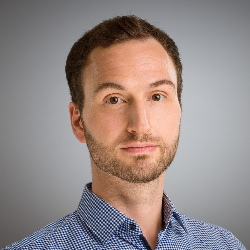
Dr. Borut Černe
RD Motion, d.o.o.
Dr. Borut Černe is a cofounder and Co-CEO at RD Motion. Having previously worked at the University of Ljubljana, he has more than 11 years of research experience in solid mechanics, polymers testing, gear design and testing, engineering design and power transmissions. His research has mostly been focused on numerical modeling of engineering polymers with focus on polymer power transmissions, along with testing and development of novel experimental methodologies for this type of applications. As part of his work at RD Motion, he is mostly involved in R&D operations including test rig development, testing execution and data analysis.

Dr. Riccardo Longato
Longato Riccardo Srls
Dr. Riccardo Longato earned his physics degree in 1996. In 2004, he began working at GSM Gearboxes S.p.A. as the Manager of Northeast Italy for special gearboxes. From 2010 until 2013, he worked at S.I.T.I. Gearboxes S.p.A as a developer of special industrial applications gearboxes. He then worked at GB Gearboxes S.p.A. from 2013 until 2016 as the Technical Manager, R&D. Since 2004 at ATHESIS A.P.T. S.p.A., he has been in the working group that developed a four square test bench (250 kW) and developed new industrial gearboxes (now Piv Posiplan). He is the inventor of N° BO2013A 00611 “Synchronized speed change for agricultural gearboxes” and is now the CEO of start-up Longato Riccardo srls.

Lorenzo Pagliari, M.Sc
Free University of Bozen/Bolzano
Lorenzo Pagliari completed his master’s degree in mechanical engineering at the Free University of Bozen-Bolzano (Italy) and is now a second year PhD student at the same university. His research is mainly focused on multiaxial fatigue analysis, specifically on the employment of criteria for the life prediction of components under multiaxial low-cycle fatigue. Being captivated by the world of gears and power transmission, he carries out multiaxial fatigue analysis on gears, digging into the mostly unexplored topic of low cycle fatigue of gear teeth.

Qianchen Zeng
Worscester Polytechnic Institue
Qianchen Zeng graduated from Worcester Polytechnic Institute (WPI) with a bachelor’s degree and is now a PhD student at WPI. He studies manufacturing engineering under the Mechanical and Materials Engineering Department, focusing on additive manufacturing and microstructure optimization of steel alloys.
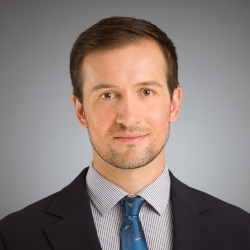
Dr. Damijan Zorko
RD Motion, d.o.o.
Dr. Damijan Zorko is a Co-founder and Co-CEO at RD Motion. He studied mechanical engineering at University of Ljubljana, and received his Ph.D. in 2019. Having 15 years of experience on gear transmissions, he was deeply involved in developing RD Motion’s modern test benches and testing methods for experimental research on gears. While working at RD Motion, he has been collaborating with world-leading companies from several different industry sectors, such as automotive, aerospace, materials, e-mobility, appliances, and chemical. He has authored more than 50 scientific and technical papers, published in elite scientific journals, and has held lectures at top conferences hosted by engineering associations ASME, VDI, and JSME.
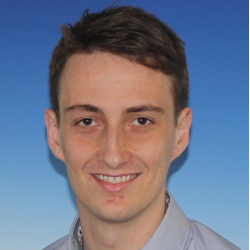
Jonas-Frederick Berger (b. Hochrein)
Institute of Machine Elements, Gear Research Center (FZG), TUM School of Engineering and Design, Technical University of Munich
Jonas Berger is a research associate and team Leader for gear calculation software at the Institute of Machine Elements / Gear Research Center (FZG) at the Technical University of Munich in Germany. His research focuses on loaded tooth contact simulation (LTCA) and gear geometry, with a strong focus on face gear drives and cylindrical gearings. In particular, the calculation of gear stiffness by combining modern numerical and conventional analytical methods is one of his main topics. Jonas holds a bachelor’s and a master’s degree in mechanical engineering from the Technical University of Munich. He is currently a PhD candidate at FZG. He is presenting for the first time at the AGMA Fall Technical Meeting.

Timo Giese
FunctionBay GmbH
Timo Giese holds a degree in mechanical engineering from Technical University Munich (TUM). He is currently Technical Director at Function Bay Munich. Giese’s research interests are focused on NVH simulation of gearboxes, dynamic simulation of machine tools and simulation of tracked vehicles.
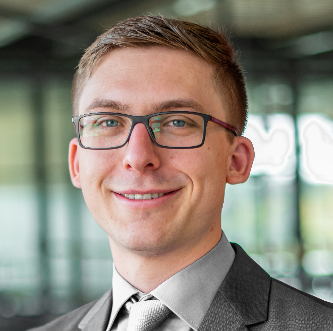
Laurenz Roth, M.Sc
Laboratory for Machine Tools and Production Engineering (WZL) of RWTH Aachen University
Laurenz Roth earned his bachelor’s degree in 2019 in mechanical engineering from RWTH Aachen University, specializing in automotive engineering. He then did his master studies in automotive engineering and transportation at RWTH Aachen University, earning his degree in April 2021. Since June 2021, he has been a research associate at the Machine Tool Laboratory (WZL) of RWTH Aachen University, Chair of Machine Tools, Group Gearbox NVH. In this role, he worked on the design of cylindrical gears, planning, execution and evaluation of test bench investigations, and simulation setup for the determination of excitation and noise behavior. He also participates in research activity on these topics.
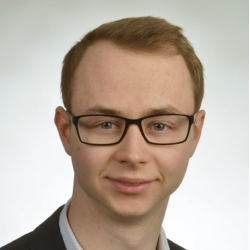
Mathis Steinrötter
Ruhr University Bochum
Mathis Steinrötter is a research associate at Ruhr University in Bochum, Germany. He earned his bachelor’s and master’s degrees in mechanical engineering in Bochum, focusing on gear transmissions. Since 2023, he has been researching scuffing load capacities of high-speed spur gears.

Carlos Wink
Eaton Corporation
Carlos Wink is a Chief Engineer with Eaton Mobility Group in Galesburg, Michigan. He has over 30 years of experience in the gear industry working on power transfer systems for automotive, comercial vehicles, aerospace, and electrical equipment applications. More recently his work has been primarily focused on gear drive units of electric mobility. Wink holds a Ph.D. and a master’s degree in mechanical engineering, both from University of Campinas, and holds a Bachelor of Science in Mechanical Engineering from University of Saint Cecilia in Brazil. He has published 32 technical papers and holds 5 patents.
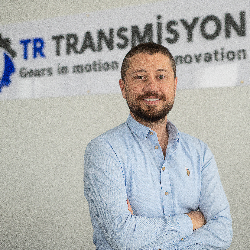
Mert Vardar
Tr Transmisyon Engineering
Mert Vardar is a leading gearbox and transmission consultant and the Head of Transmission Development at TR Transmisyon Mühendislik A.Ş., specializing in high-precision gear systems for defense and aerospace. With a Bachelor of Science in mechanical engineering, he has over 15 years of experience, notably contributing to projects like the first indigenous turbofan accessory gearbox and T-625 helicopter transmission systems. Mert excels in advanced simulation tools, holding several patents for innovative gearbox mechanisms. He’s a regular presenter at international conferences and an active British Gear Association member. With expertise in complex transmission layouts, his recent patent work, including the Orbicular Gear Mechanism, has been pivotal in advancing gearbox technology.
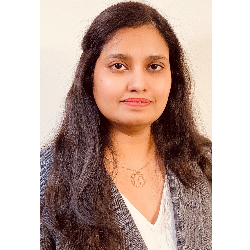
Dr. Anusha Anisetti
Eaton Corporation
Anu Anisetti is currently employed at Eaton Corporation as a Lead Engineer specializing in cylindrical gears for transmission, electrical drive units, and differentials. She has a PhD in Mechanical Engineering with focus on Gear technology, tribology, computational dynamics and optimization. Her professional experience has been primarily in Design, Research and Development. Her participation in various AGMA trainings and being a member goes back over 5+ years. She has served as peer reviewer on various international gearing journals.
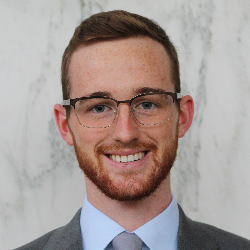
Riley Damm
The Ohio State University
Riley Damm is a Graduate Research Associate with the Gear and Power Transmission Research Laboratory, part of the Department of Mechanical and Aerospace Engineering at The Ohio State University. His research focus is on understanding cumulative fatigue damage behaviors in gearing applications through experimental studies, utilizing single tooth bending fatigue test methodologies and comparing that to theoretical cumulative damage models.

Adam Foltz
Purdue University in Indianapolis
Adam D. Foltz is a PhD candidate at Purdue University in Indianapolis, focusing his research on loaded tooth contact analysis. He is currently a Senior Engineer at FEV NA, where he has consults on a number of gearbox related projects, particularly in the field of gear NVH. Adam has previously worked at Allison Transmission where he first learned gear design, and Cummins Inc. where he first learned gear dynamics.
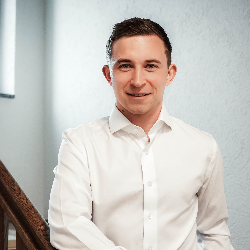
Michael Geitner
Gear Research Center (FZG), Technical University of Munich
Michael Geitner is currently Team Leader for Materials and Heat Treatment in the Load Carrying Capacity of Cylindrical Gears department at the Gear Research Center (FZG, Technical University of Munich). Here, he also contributes as active member in different standardization committees. He is designated Head of Department for Worm Gears and Bevel Gears, Fatigue Life Analysis research and will soon finish his PhD at FZG. He has bachelor and master degrees, both in mechanical engineering from his alma mater, Technical University of Munich. This paper goes over his PhD research. It’s his first time at AGMA Fall Technical Meeting.
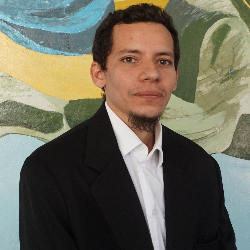
Bruno Henrique Lima, M.Sc
Instituto Tecnológico de Aeronáutica
Bruno has a degree in Metalurgical Engineering from Federal University of Ceará (2019) in Brazil and a Master of Science degree from Instituto Tecnológico de Aeronáutica (ITA) (2022). He is currently a research assistant and PhD student at the Competence Center in Manufacturing of ITA (CCM-ITA) and member of the Gear Inovation Group (GIE) where he works with surface integrity and residual stress analysis. He has experience in the area of identification and failure analysis of gears with emphasis in micromagnetic methods.

Dr. Burkhard Pinnekamp
RENK GmbH (retired)
Dr. Burkhard Pinnekamp earned a Mechanical Engineering degree in 1987 and his PhD in 1992 at the Gear Research Center (FZG), Technical University of Munich. He then continued his work at FZG as chief engineer in the field of continuously variable transmission and hybrid car propulsion systems. From 1996 to 1999, he was the deputy chief designer for marine gears at RENK AG, in Augsburg. From 1999 to 2001, he was the head of design industrial gears, and from 2001 to 2004 the head of design high speed gears at RENK AG, Augsburg. He was with RENK Corporation, USA, from 2004 to 2006 for various gear programs. From 2006 to 2024, he was Head of the Central Technology Division at RENK GmbH focusing on R&D, gear calculation, programming, structural and dynamic analyses. Since May 2024, he has been on an early retirement program with RENK. He is still the President of the Research Association for Drive Technology (FVA e.V.) in Frankfurt.

Johannes Rolzhäuser
Laboratory for Machine Tools (WZL) of RWTH Aachen University
Johannes Rolzhäuser is currently a research assistant in the Gear Department of the Laboratory for Machine Tools and Production Engineering (WZL) of RWTH Aachen University. Parallel to his studies, he started to work as research student assistant in the groups Gear Power Density and Gear Acoustics at WZL. After finishing his Bachelor and Master degree in mechanical engineering at RWTH Aachen, he started his career as a Calculation Engineer for wind turbine gearboxes at Flender GmbH. After two and a half years in industry he returned to Gear Department of WZL, where he is focusing on simulation and testing of tooth flank fracture failure mechanism in his PhD studies.

Benjamin Beckelynck, B.ING, M.Sc
Optimec Consultants Inc.
Benjamin holds a Masters degree in Aeronautical Engineering from IPSA, France (2013), and a Master of Science in Mechanical Engineering from Laval University, Quebec (2016). He conducted research on delamination in aerospace composites for CRIAQ projects. Since joining Optimec Consultants in Montreal in 2016, he has amassed a decade of experience in FEA and CFD analyses. Benjamin has led numerous multi-physics simulation projects and is responsible for developing high-fidelity analysis workflows for structural integrity, design optimization, and virtual testing, ensuring comprehensive and detailed insights.

Prashant Bardia
John Deere India
Prashant Bardia is an NVH Engineer at John Deere India Pvt. Ltd. He received his BTech-Mechanical Engineering from NIT Kurukshetra, India and his ME-Mechanical from IISc, Bangalore, India. He has 19 years of experience, mainly in the automotive off-highway domain. he began his career in GE-JFWTC-Energy and has been working at John Deere for the past 17 years. In his current role, he is involved in NVH testing and analysis for utility tractors. This includes homologation noise testing, noise source identification, ranking of the sources, noise quality, vehicle and component level vibration testing, ODS and impact testing, and root cause analysis.

Dr. Jennifer Clark
The Lubrizol Corporation
Dr. Jennifer Clark is a Technology Development Manager for Industrial Grease Additives at The Lubrizol Corporation. She holds a Ph.D. in Organic chemistry from the State University of New York – Buffalo. She has 4 years in the grease industry focusing on Open Gear Lubricant Technology, overbased calcium sulfonates and new alternatives for to lithium greases. Previous to becoming a Technology Development Manager for Industrial Grease, Jennifer spent seven years in Metalworking with a focus on new rust preventive technology.

Dr. Franco Concli, Prof.-Ing.
Free University of Bozen/Bolzano
Franco Concli received his MSc in Mechanical Engineering in 2009 at Politecnico-di-Milano. He developed his MD thesis about structural damages of helicopter gearboxes. He graduated Ph.D. in 2013 (Politecnico-di-Milano). The title of his Ph.D. thesis is “Efficiency of gear transmissions and CFD analisys of load independent power losses”. In 2012 he had a reseach fellowship at the FZG (TU-Munich).
After working for Bonfiglioli-Mechatronic-Research, from 2017 Franco Concli is working at the Free-University-of-Bolzano, where in 2022 become Associate Professor. He is the head of the Material-Characterization-Lab and of the Rapid-Prototyping-and-Additive-Manufacturing-Lab.
His research fields include the development of CFD tools for the prediction of power losses, thermal regimes and efficiency of gearboxes and fatigue.
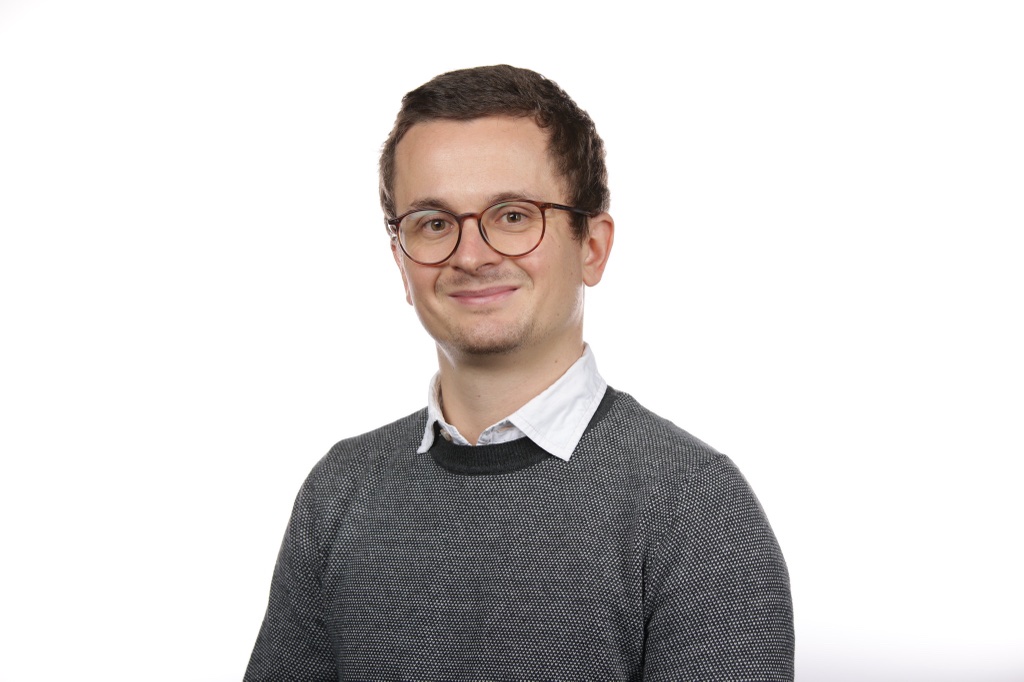
Benjamin Legrady
Dive Solutions GmbH
Benjamin Legrady earned his mechanical engineering degree (Dipl.Ing) at the Techncial University of Dresden in 2020. From 2020 to 2022, he was a Customer Success Engineer at Dive Solutions GmbH, where he helped engineers around the world achieve their business goals with Dive Solutions’ cloud-native simulation platform. Since 2022, he has been Customer Success Lead at Dive Solutions and is responsible for globally leading sales engineering, customer support, and customer success. He has had multiple papers published and has given presentations at several conferences, including the International Conference on Gears, the AGMA FTM, NAFEMS, and SPHERIC.
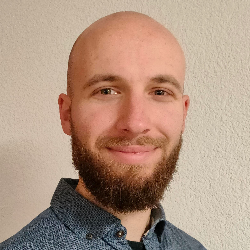
Felix Müller, M.Sc
Chair of Machine Elements, Gears, and Tribology (MEGT), Rheinland-Pfälzische Technische Universität (RPTU)
Felix Müller is currently a Research Assistant at the Chair of Machine Elements, Gears, and Tribology (MEGT) at Rheinland-Pfälzische Technische Universität (RPTU), a position he has held since 2023. He also leads the Mechanical Drive Technology group. Felix holds both Bachelors and Masters degrees in mechanical engineering. His current research focuses on worm gears and grease lubrication.

Dr. Peter Schmidt, PE
United Protective Technologies, LLC, UNCC PORTAL
Peter Schmidt is the Lead Research Engineer for United Protective Technologies, LLC UNCC PORTAL office. He holds Bachelors, Masters, and Doctoral degrees, all in Mechanical Engineering. His professional experience spans over 35 years of practice, with experience at DoD, commercial manufacturing facilities, consulting, and as an academic, holding appointments at two universities, achieving the rank of full professor before joining his current firm. He is a licensed professional engineer in two states.

Benjamin Abert
FVA GmbH
Benjamin Abert is currently Head of Consulting and Service at FVA GmbH. In this role, he supports customers in using the FVA Workbench, prioritizes customer requirements and passes the requirements on to software development for implementation. Mr. Abert started his career at FVA GmbH as a calculation engineer for plain and rolling bearings with a Master of Science degree from the Technical University of Clausthal. Academically, Mr. Abert worked on the simulation of hydrodynamic contacts.
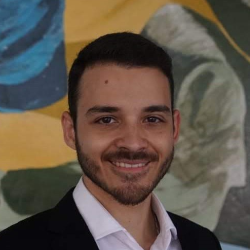
Angelo Carvalho, M.Sc
Instituto Tecnológico de Aeronáutica
On-going Doctorate in Aeronautics and Mechanical Engineering at Aeronautics Institute of Technology – ITA , Brazil (since 2020). Master of Science in Aeronautics and Mechanical Engineering at ITA (2020). Bachelor in Materials Engineering at Federal University of São Paulo, Brazil (2018). Currently research assistant of the Gear Innovation Group (GIE) at the Competence Center in Manufacturing (CCM-ITA), where is the leader of gear calculation and acts as technical manager and technical advisor of industrial research projects.

Jörg Lohmann, Dipl.-Ing.
EMAG Koepfer GmbH
Jörg Lohmann is the Directory of Technology & Project Management and Member of the Board at EMAG Koepfer GmbH. He began his career with an apprenticeship at Heckler & Koch GmbH, studied mechanical engineering and automation technology at Furtwangen University and gained practical experience in research and development at Gildemeister Italiana S.p.A. in Bergamo. In 2005, he joined KOEPFER Verzahnungsmaschinen GmbH as a sales engineer in the sales and marketing department. Five years later, he was appointed vice sales director. He became sales director of EMAG Koepfer GmbH in 2014, directory of the technology departments in 2019 and was appointed as a member of the board in 2021.

Lennart Schierholz, M.Sc
Ruhr University Bochum
Lennart Schierholz is a research associate at Ruhr University in Bochum, Germany. He earned his bachelor’s and master’s degrees in mechanical engineering in Clausthal, focusing on structural durability and tribology. Since 2022, he has been researching micropitting load carrying capacities of large module spur gears.

Dr. Zhaoyao Shi
Beijing Engineering Research Center of Precision Measurement Technology and Instruments, Beijing University of Technology
Dr. Shi Zhaoyao is currently Chair Professor of the “Yangtze River Scholars Program” for the Ministry of Education, China. His activities involve gear engineering, metrology, and instruments. He has 18-year industry and 20-year university experiences, including research work at the PTB of Germany and the Cranfield University, UK. He is a distinguished gear expert, a member of the ISO/TC 60 (Gears) WG2, Vice President of CGMA (China Gear Manufacturers Association) and Vice Director of SAC/TC 52 (Gears), China. He has been awarded among the China National, Provincial and Industrial Awards for his contributions to high-speed train gearboxes (420km/h), face gear drives, the smart micro gearbox, and mini MIM/PM gears. He is the author or co-author of over 180 scientific papers and inventor of 62 patents.
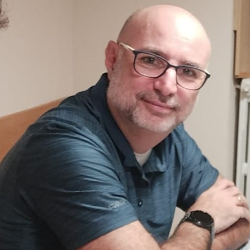
Dr. Massimiliano Turci
Studio Tecnico Turci
Max Turci is a consultant in gears and cam mechanisms design. He received his master’s degree in mechanical engineering at University of Bologna in 1996. He began as a CAD manager and he developed X-Camme, a software for the design of cam mechanism. In 2004 he started working on gears as application engineer for KISSsoft: now he is the team leader of the Italian technical staff of KISSsoft. His professional experience is primarily in the development of computational models for industrial gearboxes and vehicle transmissions. He is a member of the AGMA worm gear committee and some ISO WG for gears. As a mechanical engineer, he is an expert witness for the civil court.

Dr. Maximilian Zimmer
Reishauer AG
Dr. Maximilian Zimmer is currently CTO at Reishauer AG, a Swiss company and market leader for generating grinding machines and corresponding tools. He started at Reishauer from July 2016 on as a project manager in the technology development and was leading the technology group from 2019 to 2023. The focus of his work is technology innovation with strong regard to E-motive NVH and gear manufacturing topics. He has a PhD in mechanical engineering from the Technical University Munich, where he researched on design and optimization of gears of arbitrary axis positions at the Institute of Machine Elements, following up his studies of mechanical engineering from 2005 to 2010.
Sponsors
Headline Sponsor

AGMA’s On-Site Safety Protocols for COVID-19
In order to keep attendees safe, AGMA will be complying with COVID-19 safety guidelines and local regulations in all event spaces.
If you have any questions regarding these protocols, please email FTM@agma.org.
Cancellation and Payment Policy
Please view our cancellation policy here. Please view our code of conduct here.
